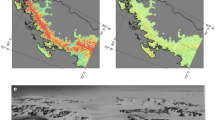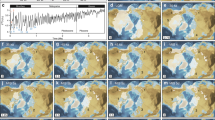Abstract
Ice-sheet development in Antarctica was a result of significant and rapid global climate change about 34 million years ago1. Ice-sheet and climate modelling suggest reductions in atmospheric carbon dioxide (less than three times the pre-industrial level of 280 parts per million by volume) that, in conjunction with the development of the Antarctic Circumpolar Current, led to cooling and glaciation paced by changes in Earth’s orbit2. Based on the present subglacial topography, numerical models point to ice-sheet genesis on mountain massifs of Antarctica, including the Gamburtsev mountains at Dome A, the centre of the present ice sheet2,3. Our lack of knowledge of the present-day topography of the Gamburtsev mountains4 means, however, that the nature of early glaciation and subsequent development of a continental-sized ice sheet are uncertain. Here we present radar information about the base of the ice at Dome A, revealing classic Alpine topography with pre-existing river valleys overdeepened by valley glaciers formed when the mean summer surface temperature was around 3 °C. This landscape is likely to have developed during the initial phases of Antarctic glaciation. According to Antarctic climate history (estimated from offshore sediment records) the Gamburtsev mountains are probably older than 34 million years and were the main centre for ice-sheet growth. Moreover, the landscape has most probably been preserved beneath the present ice sheet for around 14 million years.
This is a preview of subscription content, access via your institution
Access options
Subscribe to this journal
Receive 51 print issues and online access
$199.00 per year
only $3.90 per issue
Buy this article
- Purchase on Springer Link
- Instant access to full article PDF
Prices may be subject to local taxes which are calculated during checkout



Similar content being viewed by others
References
Zachos, J. C., Pagani, M., Sloan, L., Thomas, E. & Billups, K. Trends, rhythms, and aberrations in global climate 65 Ma to present. Science 292, 686–693 (2001)
DeConto, R. M. & Pollard, D. Rapid Cenozoic glaciation of Antarctica induced by declining atmospheric CO2 . Nature 421, 245–249 (2003)
Huybrechts, P. Glaciological modelling of the Late Cenozoic East Antarctic ice sheet: stability or dynamism? Geogr. Ann. 75, 221–238 (1993)
Lythe, M., Vaughan, D. G. & BEDMAP Consortium . BEDMAP: a new thickness and subglacial topographic model of Antarctica. J. Geophys. Res. 106, 11335–11352 (2001)
Shevenell, A. E., Kennett, J. P. & Lea, D. W. Middle Miocene Southern Ocean cooling and Antarctic cryosphere expansion. Science 305, 1766–1770 (2004)
Holbourn, A., Kuhn, W., Schulz, M. & Erlenkeuser, H. Impacts of orbital forcing and atmospheric carbon dioxide on Miocene ice-sheet expansion. Nature 438, 483–487 (2005)
Lewis, A. R. et al. Mid-Miocene cooling and the extinction of tundra in continental Antarctica. Proc. Natl Acad. Sci. USA 105, 10676–10680 (2008)
Jamieson, S. S. R. & Sugden, D. E. in Antarctica, a Keystone in a Changing World (eds Cooper, A. et al.) 39–54 (National Academies Press, 2007)
Pekar, S. F. & DeConto, R. M. High-resolution ice-volume estimates for the early Miocene: evidence for a dynamic ice sheet in Antarctica. Palaeogeog. Palaeoclimatol. Palaeoecol. 231, 101–109 (2005)
Naish, T. R. et al. Orbitally induced oscillations in the East Antarctic ice sheet at the Oligocene/Miocene boundary. Nature 413, 719–723 (2001)
Barrett, P. J. in Glacial Processes and Products (eds Hambrey, M. J. et al.). Vol. 39 259–287 (International Association of Sedimentologists, Special Publication, 2007)
Summerfield, M. A. et al. Cosmogenic isotope data support previous evidence of extremely low rates of denudation in the Dry Valleys region, southern Victoria Land. Geol. Soc. Lond. Spec. Publ. 162, 255–267 (1999)
Lewis, A. R., Marchant, D. R., Ashworth, A. C., Hemming, S. R. & Machlus, M. L. Major middle Miocene global climate change: evidence from East Antarctica and the Transantarctic Mountains. Geol. Soc. Am. Bull. 119, 1449–1461 (2007)
Marchant, D. R. et al. Formation of patterned ground and sublimation till over Miocene glacier ice, southern Victoria Land, Antarctica. Geol. Soc. Am. Bull. 114, 718–730 (2002)
Drewry, D. J. Antarctica: Glaciological and Geophysical Folio (Scott Polar Research Institute, Univ. Cambridge, 1983)
Perkins, D. Subglacial Landscape in Antarctica. PhD thesis, Univ. Aberdeen (1984)
Watson, D. Contouring: A Guide to the Analysis and Display of Spatial Data 1–321 (Pergamon, 1992)
Tarboton, D. G., Bras, R. L. & Rodrigueziturbe, I. On the extraction of channel networks from digital elevation data. Hydrol. Process. 5, 81–100 (1991)
Jamieson, S. S. R., Hulton, N. R. J. & Hagdorn, M. Modelling landscape evolution under ice sheets. Geomorphology 97, 91–98 (2008)
Anderson, R. S., Molnar, P. & Kessler, M. A. Features of glacial valley profiles simply explained. J. Geophys. Res. 111 F01004 10.1029/2005JF000344 (2006)
MacGregor, K. C., Anderson, R. S., Anderson, S. P. & Waddington, E. D. Numerical simulations of longitudinal profile evolution of glacial valleys. Geology 28, 1031–1034 (2000)
Amerson, B. E., Montgomery, D. R. & Meyer, G. Relative size of fluvial and glaciated valleys in central Idaho. Geomorphology 93, 537–547 (2008)
Montgomery, D. R. Valley formation by fluvial and glacial erosion. Geology 30, 1047–1050 (2002)
Siegert, M. J., Taylor, J. & Payne, A. J. Spectral roughness of subglacial topography and implications for former ice-sheet dynamics in East Antarctica. Glob. Planet. Change 45, 249–263 (2005)
Paterson, W. S. B. The Physics of Glaciers 3rd edn 1–480 (Pergamon, 1994)
Raine, J. I. & Askin, R. A. Terrestrial palynology of Cape Roberts drillhole CRP-3, Victoria Land Basin, Antarctica. Terra Antarct. 8, 389–400 (2001)
Ehrmann, W. U., Setti, M. & Marinoni, L. Clay minerals in Cenozoic sediments off Cape Roberts (McMurdo Sound, Antarctica) reveal the palaeoclimatic history. Palaeogeogr. Palaeoclim. Palaeoecol. 229, 187–211 (2005)
DeConto, R. M. & Pollard, D. A coupled climate-ice sheet modeling approach to the early Cenozoic histoy of the Antarctic ice sheet. Palaeogeogr. Palaeoclimatol. Palaeoecol. 198, 39–53 (2003)
Harwood, D. M., McMinn, A. & Quilty, P. G. Diatom biostratigraphy and age of the Pliocene Sørsdal Formation, Vestfold Hills, East Antarctica. Antarct. Sci. 12, 443–462 (2000)
Abramov, O. & McEwen, A. Technical note: An evaluation of interpolation methods for Mars Orbiter Laser Altimeter (MOLA) data. Int. J. Remote Sens. 25, 669–676 (2004)
Acknowledgements
This paper is based upon work supported by the National Natural Science Foundation of China (40476005), the International Polar Year programme CHINARE (Ministry of Science and Technology of China 2006BAB18B03) and the UK Natural Environment Research Council (NE/D003733/1). We thank A. Wright for drawing Fig. 1c.
Author Contributions S.B., C.X., J.Y., T.X. and L.Y. collected and processed radar data. S.F. prepared and provided a radar system in the 2004/2005 season, and gave support and advice on the radar technique, data collection and data processing. M.J.S. and D.S. provided knowledge of Antarctic glacial history and glacial dynamics. S.M.M. analysed the DEM for quantitative information on the dendritic network and landform features. M.J.S., D.S., S.M.M. and S.B. wrote the paper. All authors discussed the results and commented on the manuscript.
Author information
Authors and Affiliations
Corresponding authors
Supplementary information
Supplementary Information
This file contains Supplementary Figures 1-3 with Legends, Supplementary Methods including Supplementary Figures SMI and SM2 and 3 Supplementary Discussions. (PDF 2560 kb)
Rights and permissions
About this article
Cite this article
Bo, S., Siegert, M., Mudd, S. et al. The Gamburtsev mountains and the origin and early evolution of the Antarctic Ice Sheet. Nature 459, 690–693 (2009). https://doi.org/10.1038/nature08024
Received:
Accepted:
Issue Date:
DOI: https://doi.org/10.1038/nature08024
This article is cited by
-
Scars of tectonism promote ice-sheet nucleation from Hercules Dome into West Antarctica
Nature Geoscience (2023)
-
An ancient river landscape preserved beneath the East Antarctic Ice Sheet
Nature Communications (2023)
-
Multi-proxy evidence for sea level fall at the onset of the Eocene-Oligocene transition
Nature Communications (2023)
-
China’s Recent Progresses in Polar Climate Change and Its Interactions with the Global Climate System
Advances in Atmospheric Sciences (2023)
-
60 million years of glaciation in the Transantarctic Mountains
Nature Communications (2022)
Comments
By submitting a comment you agree to abide by our Terms and Community Guidelines. If you find something abusive or that does not comply with our terms or guidelines please flag it as inappropriate.



